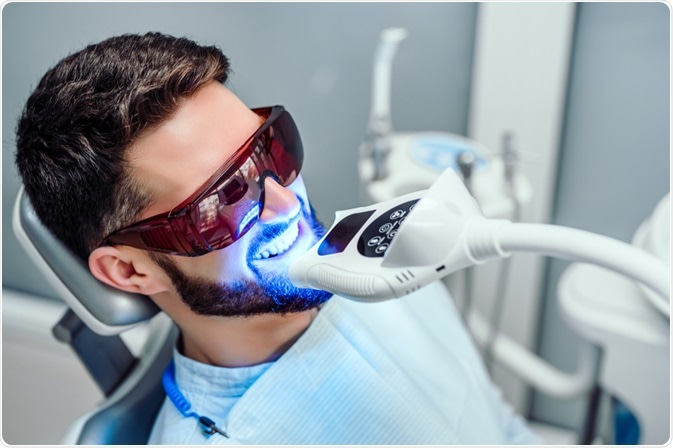Teeth whitening is one of the most popular dental procedures, resulting in a brighter and healthier smile, which can boost self-confidence. Unfortunately, it is not an everlasting procedure and can get easily reversed due to habits like smoking and dietary choices.

Image Credit: Harbucks/Shutterstock.com
Reversal of teeth whitening can be an unpleasant experience as it is a time consuming and expensive procedure. Thus, it is advisable to adopt healthy habits to preserve the effects of the procedure.
What are the potential risks post teeth whitening procedure?
Teeth are the hardest structure of the human body. They consist of multiple layers with enamel being the hardest and outermost layer encapsulating the dentin layer.
A person feels tooth sensitivity when dentin is exposed due to mechanical injury or chemical erosion of enamel. Below are certain side effects which may manifest post tooth whitening procedure:
- Exposure to the dentin layer– Hydrogen Peroxide is the main component used during the teeth whitening process, but this chemical can lead to a temporary exposure of the dentin. Once dentin is exposed it can lead to sensitivity of the teeth and increases the probability of discoloration.
- Irritation to the gums-Gum irritation is one of the common side effects of the tooth whitening procedure. Though the procedure does not result in permanent damage to the gum tissue, however, it is advisable to gently treat the gums post-procedure.
What are the various factors that can cause discoloration of teeth?
Some foods contain certain substances that are responsible for tooth discoloration that include acids, chromogens, and tannins. These components can easily cause staining of the enamel or may leave the enamel fragile, which gives an easy passage for these components for settling on the tooth surface.
Hence, it is advisable to refrain from foods loaded with these components for a minimum period of 48 hours post bleaching.
Five cumulative studies have been conducted to understand the effect of the kind of food consumed pre, post, and during the tooth whitening process. These studies were approved by the Institutional Review Board at Indiana University and Purdue University in Indianapolis.
Results were analyzed and it was concluded that participants who did not adhere to a white diet before the tooth whitening process observed a striking color change. These studies also concluded that the intake of foods and drinks which are not categorized as white did not affect the tooth whitening process.
However, these studies indicated that if the white diet is not consumed post the tooth whitening procedure then there is a high risk of reversal of the process hence leading to re-staining of the teeth.
One clinical trial was conducted to assess the effect of cola- based drinks on teeth post the dental bleaching process. The results revealed that even though consumption of cola-based drinks did not affect the whitening process, the threshold of bleaching induced tooth sensitivity was observed to a greater extent.
Which foods and drinks should be avoided post tooth whitening process?
Though restricting to white diet is the best approach post-whitening procedure; however, there are certain food types which should be avoided. As a rule of thumb, it is advisable to refrain from foods that can stain a white shirt.
Below is the list of such foods that should be strictly avoided post-whitening procedure.
- Foods that are dark in color: Certain foods like beetroot, blueberries, dark chocolate, and certain dark-colored sauces should be completely avoided and should be replaced with white sauces. For instance, if pasta is a preferred form of a meal then it is a good option to switch from red pasta to white pasta. Also, if at times it is unavoidable to eat dark-colored sauces then it is better to consume lots of green leafy vegetables like spinach, kale, or broccoli. These vegetables, when consumed in raw form have the potential to remove the staining caused due to consumption of red-colored foods.
- Dark-colored beverages: Drinks like coffee and tea are loaded with caffeine which can result in stains on teeth. Even red wine should be completely avoided post-whitening procedure.
- Foods and drinks acidic in nature: Even though fruits are considered as one of the healthiest options but acidic fruits like grapes, oranges, cranberry are particularly low in pH concentration which once consumed increases the acidic nature of saliva. Highly acidic saliva has the potential to further harm the enamel which has been previously weakened by the tooth bleaching process.
Vinegar which is commonly used as a salad dressing should be avoided because of its highly acidic nature. But if it is unavoidable to eat such foods then the best trick is to consume raw vegetables like lettuce soon after consuming these foods to nullify the acidic effect.
Sources:
- Ultrasmile dentistry. The White Diet: Foods You Can and Cannot Eat After Teeth Whitening. www.ultrasmile.co.uk/…/
- SS Azer.et al.(2019). Effect of bleaching on tooth discolouration from food colourant in vitro. https://www.ncbi.nlm.nih.gov/pubmed/21958473
- V Hass et al (2019) Effects of Exposure to Cola-Based Soft Drink on Bleaching Effectiveness and Tooth Sensitivity of In-Office Bleaching: A Blind Clinical Trial. https://www.ncbi.nlm.nih.gov/pubmed/31908538
- Matis BA et al (2015) White Diet: Is It Necessary During
- https://www.jopdentonline.org/doi/pdf/10.2341/14-019-LIT
- Karadas Muhammet et al (2014).The effect of different drinks on tooth color after home bleachinghttps://www.ncbi.nlm.nih.gov/pmc/articles/PMC4054058/
Further Reading
- All Teeth Whitening Content
- What is Teeth Whitening?
- Are Teeth Whitening Kits Safe?
Last Updated: Jun 2, 2020

Written by
Akshima Sahi
Akshima is a registered dentist and seasoned medical writer from Dharamshala, India. Akshima is actively involved in educating people about the importance of good dental health. She examines patients and lends free counseling sessions. Taking her passion for medical writing ahead, her aim is to educate the masses about the value of good oral health.
Source: Read Full Article
